EMD GP40-based passenger locomotives
| EMD GP40-based passenger locomotives | |
|---|---|
| Type and origin | |
| Power type | Diesel-electric |
| Builder | Electro-Motive Diesel (EMD) |
| Specifications | |
| AAR wheel arr. | B-B |
| UIC classification | Bo'Bo' |
| Gauge | 4 ft 8 1⁄2 in (1,435 mm) |
The EMD GP40-based passenger locomotives were derivatives of the General Motors EMD GP40 diesel-electric locomotive. For passenger service, the locomotives required extra components for providing steam or head-end power (HEP) for heating, lighting and electricity in passenger cars.
GP40TC
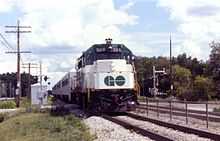
The GMD GP40TC was built by General Motors Diesel (GMD), for GO Transit in Toronto, Ontario (The 'TC' stood for 'Toronto Commuter'). A total of eight units were manufactured between 1966-1968. They were built on an enlarged frame to accommodate a HEP genset. GO Transit numbered these units 600-607.[1]:55 GO Transit sold the fleet to Amtrak in 1988; Amtrak numbered them 192-197.[2]:106 For Amtrak service the 575-volt HEP engine / generator set was replaced with one for 480-volt HEP. The units were based in Chicago and used on short-haul trains. The Norfolk Southern Railway rebuilt all eight at its Juniata Shops in Altoona, Pennsylvania. These are now classed as GP38H-3 and work maintenance-of-way trains or standby power for Downeaster trains. Amtrak renumbered them 520-527 to make room for the new GE Genesis locomotives in the 1990s.[3]
- External links
 Media related to GMD GP40TC locomotives at Wikimedia Commons
Media related to GMD GP40TC locomotives at Wikimedia Commons
GP40P
Thirteen GP40Ps were built in October 1968 for the Central Railroad of New Jersey (CNJ) and paid for by the New Jersey Department of Transportation. The CNJ put the units in service on the Raritan Valley Line and the North Jersey Coast Line (New York & Long Branch).
The CNJ was folded into Conrail in 1976, and in 1983, New Jersey Transit began operating passenger rail service in the state. Shortly after, the steam generator, which had occupied the flat end of the locomotive's long hood, was replaced with a diesel HEP generator, and the units were reclassified as GP40PH. They would later be rebuilt as GP40PH-2 units in 1991-92.
GP40-2H
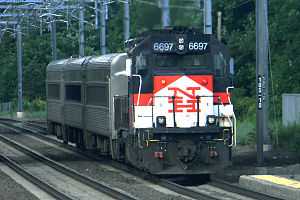
In 1996, the Connecticut Department of Transportation purchased six GP40-2 freight locomotives from CSX Transportation to replace its existing fleet of leased locomotives for use in Shore Line East service, and sent them out for rebuilding and conversion to passenger locomotives. The rebuilt locomotives were given the GP40-2H designation, and were completed by AMF Technotransport in Pointe-Saint-Charles, an area of Montreal, Quebec, Canada.
The six units came back numbered 6694 through 6699.
The GP40-2H is similar to NJ Transit's GP40PH-2 series, but sporting a smaller fuel tank.
All six units remain in Shore Line East service today. When the commuter service between New Haven, CT and Springfield, MA begins in 2016 or 2017, these six units, along with other Shore Line East equipment, will be moved into the service. M-8 EMUs, currently in operation on Metro-North's New Haven Line, will replace locomotive-hauled trains in Shore Line East service.
GP40PH-2, GP40PH-2A, GP40PH-2B
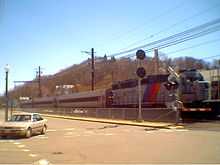
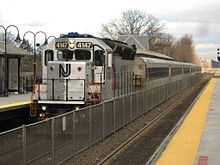
In 1991–92, NJ Transit sent its ex-CNJ GP40PH units out for rebuilding. The units were rebuilt as GP40PH-2 locomotives. At this time, the units were restricted on the Newark Division and primarily kept to the Hoboken Division. They are now found mainly on the Hoboken Division.
New Jersey Transit would later order two more sets of GP40PH-2 units; these units were rebuilt from former freight GP40 units, not from GP40P units as the first order has been. The first order (GP40PH-2A) in 1993 consisted of six units and were rebuilt by Morrison-Knudsen. The second order in 1993–94 was rebuilt by Conrail, and was for 19 former Penn Central units. These units are classified as GP40PH-2B.
Metro-North ordered a single GP40PH-2 unit; it is officially classified as a GP40PH-2M. It was rebuilt by Conrail in 1992.
A GP40PH-2 is being used on Amtrak's Piedmont train. It is owned by the North Carolina Department of Transportation rather than Amtrak itself.
GP40FH-2
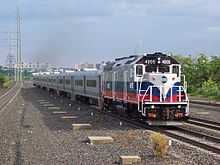
In 1987, New Jersey Transit and Metro-North ordered a set of GP40 locomotives called GP40FH-2s which were completed by Morrison Knudsen between 1987 and 1990 and combine the standard cab and frame of a GP40 with the cowl from an ex-Burlington Northern F45. A total of 21 units of this type were built; 15, numbered 4130 through 4144, were delivered to New Jersey Transit, and the remaining six, numbered 4184 through 4189, were for Metro-North.
New Jersey Transit's units are slated to be retired eventually, replaced by new PL42AC locomotives from Alstom. GP40FH-2s 4130-4134 were sent to MotivePower Industries to be rebuilt into switcher units. Metro-North has begun sending their units out for significant maintenance and upgrades. Metro-North sent units 4184-4189 to MPI in 2007, when they were rebuilt as GP40FH-2Ms 4900-4905.
As of 2015, all NJT GP40FH-2 Locomotives have been retired (except for 4139, which is used for the aqua track, a maintenance-of-way consist of a GP40FH-2, two water tanks, and a cabcar).
GP40WH-2
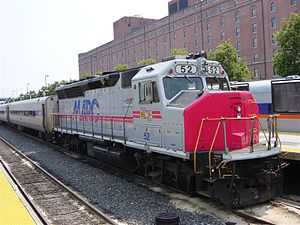
In 1993, Morrison-Knudsen was contacted by MARC to assemble a fleet of GP40s. These units are called GP40WH-2s. The GP40WH-2 is equipped with a Cummins head-end power generator and is rated at 3,000 hp (2,200 kW), allowing the locomotive to push or pull up to 6 bi-levels at up to 100 mph (160 km/h). The FRA exempted these MARC units from the "triangular light pattern" rule because the engines were ordered with Gyralites before the mandatory use of ditch lights. They are numbered 51 to 69 on the MARC roster and entered service in 1994. All but one have been retired following the completion of an order for new MP36 locomotives. Several of these have been leased by MPI to the MBTA, and others rebuilt into MP32PH-Qs for SunRail. MARC only retains one GP40WH-2, #68, for emergencies on the Amtrak Northeast Corridor all the way up to Newark Penn station. It also assistts during emergencies on the MARC Section of the Northeast Corridor named the Penn Line.
GP40-2W
All examples of this model were built by EMD for Canadian National and GO Transit. Now multiple other railroads own them. A portion of the fleet is owned by Rocky Mountaineer and pulls their passenger trains in British Columbia and Alberta. One of the units was the Spirit of Quesnel in 2009, but in 2010, Rocky Mountaineer Vacations repainted its entire fleet to celebrate their 15th anniversary.
GP39H-2
_(3803946904).jpg)
In the late 1980s, Morrison-Knudsen rebuilt six GP40s into 12-cylinder GP39s for MARC, numbered 70 to 75. They were downgraded from 3,000 horsepower (2,200 kW) to 2,300 horsepower (1,700 kW), and re-equipped with 4-stroke Cummins HEP generators providing 480 volts. Number 73 was the push unit for MARC #P286, which was involved in a fatal collision with Amtrak's Capitol Limited on February 16, 1996. 73 was rebuilt, and continues to work for MARC. The 268,000-pound GP39H-2 can push/pull a maximum of 4 cars at speeds of up to 90 mph (140 km/h).
GP40MC
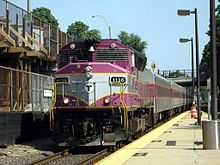
The Massachusetts Bay Transportation Authority currently owns and operates a set of 25 GP40 passenger diesels known as GP40MCs. They were originally built as GP40-2LWs for Canadian National in 1973-75. In 1997-98, these 25 units were very extensively rebuilt by AMF. In this rebuild, the units were given Cummins K19TA HEP Generators, flared radiators, computer monitoring devices, and a modern desktop cab. However, the prime mover(engine), main generator and traction motors on these units remained the same. They are still in frequent use. However, they have always been plagued by computer malfunctions and HEP Generator failures, since the units were originally used for pulling freight trains. The turbochargers, main generators, prime movers and traction motors have also not been very reliable given their original age. These units also feature steps in the middle of the engineer's side of the units. Currently, the GP40MCs are undergoing a Top-Deck Overhaul by the Norfolk Southern Railway, which includes repair and modification to the major propulsion systems and the HEP Generators. Locomotives 1116 and 1119 have been modified to be used as switchers as well as passenger units. A lower, larger step was added to the bottom of the steps on the front and rear platforms, and rear ditchlights were put on.
See also
References
- ↑ Wilson, Jeff (2009). The Model Railroader's Guide to Diesel Locomotives. Kalmbach Publishing.
- ↑ Solomon, Brian (2004). Amtrak. Saint Paul, MN: MBI. ISBN 0-760-31765-8. OCLC 56490949.
- ↑ "Amtrak Motive Power Roster". On Track On Line. March 15, 2012. Retrieved 2012-07-11.
Additional reading
- Moran, Miles (1975). "And Passenger Service Too". Railroad Modeler 5 (8): 40–47.
- "GP40 Order Numbers". The UNofficial EMD Homepage. Retrieved 2009-06-21.
External links
- Unofficial all-time NJT roster at hobokenterminal.com
- NJ Transit locomotive roster on RRPictureArchives.net
- Metro-North locomotive roster on RRPictureArchives.net
- GP40FH-2 roster on RRPictureArchives.net
| ||||||||||||||||||||||||||||||||||||||||||||
| ||||||||||